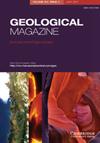中国石笋δ18O记录揭示了末次冰川中后期不同的水分轨迹
IF 2
3区 地球科学
Q3 GEOSCIENCES, MULTIDISCIPLINARY
引用次数: 0
摘要
石柱洞位于中国西南部,受印度夏季季风(ISM)和东亚夏季季风(EASM)的影响,基于30个高分辨率U-Th测年对照,我们重建了石柱洞4.5万年前至1.5万年前(ka B.P.,公元1950年以前)的石笋δ18O记录。通过与上个冰期中后期亚洲其他石笋δ18O记录的整合,我们的结果揭示了两条主要的水汽轨迹:一条是从印度洋经石笋洞到中国中部,另一条是从太平洋到中国中部和北部。从海洋到中国内陆的石笋δ18O记录平均值的系统性下降揭示了上冰期中后期水汽分馏和水汽轨迹的空间模式。相比之下,变化幅度(即海因里希期 1~4 期间与背景 δ18O 记录的偏差)显示出从沿岸大洋到中纬度中国内陆的增加趋势,呈现出 "沿海-内陆 "格局,可以用东亚冬季季候风增强和东亚季候风减弱来解释。更具体地说,HS1-HS4期间东亚冬季季候风地区石笋δ18O记录的富集是由于夏季降雨量减少或/和来自太平洋的夏季水汽资源比例增加造成的。这些新的观测结果加深了我们对EASM地区复杂的石笋δ18O记录的理解。本文章由计算机程序翻译,如有差异,请以英文原文为准。
Chinese stalagmite δ18O records reveal the diverse moisture trajectories during the middle to late last glacial period
Based on 30 high-resolution U-Th dating controls, we reconstruct stalagmite δ18 O records from 45 to 15 thousand years ago (ka B.P., before AD 1950) from the Shizhu Cave, which is located in southwestern China under the influence of both the Indian Summer Monsoon (ISM) and the East Asian Summer Monsoon (EASM). By integrating with the other stalagmite δ18 O records in Asia during the middle to late last glacial, our results reveal two main moisture trajectories: one from the Indian Ocean, through the Shizhu Cave towards central China, and the other from the Pacific Ocean to central and northern China. The systematic decrease of the average values of stalagmite δ18 O records from oceans to inland China reveals a spatial pattern of water vapour fractionation and moisture trajectory during the middle to late last glacial. In contrast, the variation amplitude, which is defined as the departures apart from the background δ18 O records during Heinrich stadials 1 to 4 (HS1–HS4), show an increasing trend from the coastal oceans to mid-latitude inland China, presenting a ‘coastal-inland’ pattern, which can be interpreted by the enhanced East Asian Winter Monsoon (EAWM) and the weakened EASM. More specifically, the enriched stalagmite δ18 O records in the EASM region during HS1 to HS4 are caused by the decreased summer rainfall amount or/and the increased proportion of summer moisture resources from the Pacific Ocean. These new observations deepen our understanding of the complicated stalagmite δ18 O records in the EASM region.
求助全文
通过发布文献求助,成功后即可免费获取论文全文。
去求助
来源期刊

Geological Magazine
地学-地球科学综合
CiteScore
4.70
自引率
0.00%
发文量
111
审稿时长
3 months
期刊介绍:
Geological Magazine, established in 1864, is one of the oldest and best-known periodicals in earth sciences. It publishes original scientific papers covering the complete spectrum of geological topics, with high quality illustrations. Its worldwide circulation and high production values, combined with Rapid Communications and Book Review sections keep the journal at the forefront of the field.
This journal is included in the Cambridge Journals open access initiative, Cambridge Open Option.
 求助内容:
求助内容: 应助结果提醒方式:
应助结果提醒方式:


